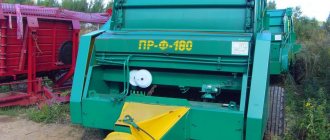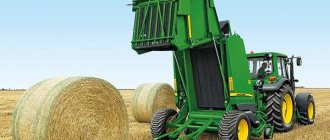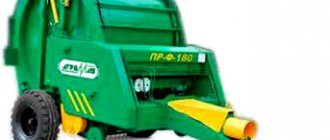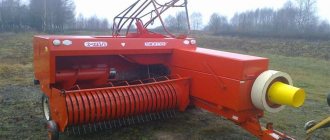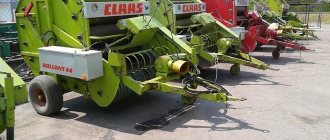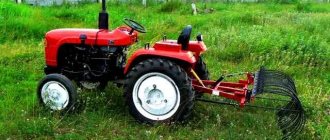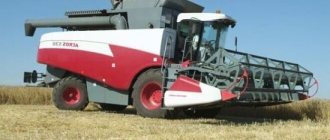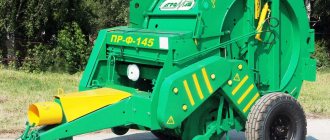After harvesting the wheat or mowing the grass, the remaining mass must be removed, but this must also be done efficiently with minimal losses. Roll balers, which are designed to pick up straw or grass and roll it into a roll, are ideal for this. The PRF 180 unit has a fairly simple and reliable design, which is capable of ensuring a minimum amount of losses.
Round baler PRF-180
In 1974, the Bobruisk plant was built for the production of fertilizer application machines, and currently it is an open joint-stock company “Managing”. In the Republic of Belarus and the CIS countries, the company is one of the largest producers of agricultural machinery.
A round baler is a trailer with a single axle and a cylindrical bale chamber. It is designed for picking up rolls of straw, pressing it and wrapping it with twine.
The result is a roll of straw with increased density on the outside and a rather loose core. This allows air to easily penetrate, which is quite important for preserving feed. Thanks to the closed design of the chamber, losses are minimized during operation.
Photo of round baler PRF-180
Adjustment and Maintenance
If you read the instructions supplied with the unit, you can conclude that for the correct operation of the product, as well as its long service life, it is necessary to timely adjust and configure the press. It involves performing the following actions:
- Set the drive clutch to a torque of 400+20 Nm, and the pick-up to 3000 Nm.
- Adjust the drive clutch of the press, making sure that the distance between the teeth of the closed chamber is 1.2-1.4 cm, and the open one is 0.5-0.6 cm.
- Make sure that the pick-up is working properly and that the chain tension is sufficient.
- Adjust bearings and press mechanism.
There are several typical problems that owners of devices of this type have to face. Often during operation, the flywheel pin is cut off, which can be eliminated by sharpening the working knives or completely replacing them. In cases where the clutch is stuck, it may be necessary to perform a preliminary run-in for 10-15 minutes.
A common problem is the inability to grab the twine when forming a roll. In such a case, it is strongly recommended to ensure that the clamps are working correctly and that they are adjusted correctly. If the device does not function properly and the twine does not feed, the problem may lie in a broken electric motor that will need to be repaired or replaced.
Device
The baler can be divided into components and assemblies, which will be described below:
- Lobovina. This is the component in which the drive is located. It consists of a power take-off shaft, a safety clutch, a shaft with coupling halves, a bevel gearbox, as well as drive shafts for the pressing mechanism and rollers. There is a loop on the front for attaching the tool to the tractor. Also on the front are drawers for tools and twine, as well as a tying device. Before opening the rear chamber, the clutch of the pressing mechanism is disconnected by means of a rope pull.
- Picker. Necessary for selecting the mass and its further feeding into the chamber. The pick-up is lifted by a hydraulic cylinder installed on the right, but it is lowered under the influence of its own weight.
- Camera base. In fact, this is a support for installing the camera itself, as well as the ear.
- Camera. Consists of two parts and is used to form a roll. On the front part there is a roller that regulates the pressing density, as well as the shaft of the pressing mechanism. The rear part can be opened and closed by hydraulic cylinders, which gives access to the finished roll.
- Pressing mechanism. It is made in the form of a chain-slat conveyor, which continuously twists the pressed mass.
- Wrapping machine.
- Hydraulic system. The hydraulic system consists of only 3 cylinders: two for controlling the rear chamber and one for the pick-up.
- The electrical equipment is extremely simple, as it only includes turn signals and an audible signal, which notifies you when the specified bale density has been reached.
In the open position, the pick-up is supported by springs and rests its wheels on the ground, and in the raised position it is secured with latches. In order to bring it into working position, you must first engage the tractor PTO, since only when the pick-up drive shaft rotates will the latches open.
Purpose of PRF 180
Before familiarizing yourself with the technical characteristics of the device, it is necessary to study its purpose and operating principle. The 180 PRF press is used to mechanize the harvesting of hay and straw, which are often used as feed for livestock.
Using a press allows you to simplify the procedure and almost completely eliminate the need for manual labor. The PRF can be used with class 1.4-2 equipment, the design of which requires the presence of a power take-off shaft.
An important feature of the product is the high quality of raw material collection, as well as the correct formation of rolls, which allows you to speed up their drying and avoid high humidity.
Operating principle
The product is a closed trailer, which, when moving behind tractor equipment, collects hay and straw using appropriate working elements. Then rolls are formed from the collected raw materials in the pressing chamber, which are securely fixed using a rope.
Be sure to read: Yenisei 1200 combine harvester
The weight of each roll can vary from 400 to 700 kg, depending on the equipment modification used. Each formed roll has a loose core, which promotes better air circulation, which is especially important for drying and long-term storage.
Device
The roll press of this modification is a simple and reliable unit that makes the process of collecting hay much more efficient. A characteristic feature of the product is its thoughtful design, characterized by a long service life and ease of operation.
When studying the structure of the press, it is advisable to highlight the following elements:
- the frontal part, where the units used to connect to the tractor, the drive shaft, and tool and twine boxes are located;
- frame used for mounting the working chamber;
- working body - a picker, reminiscent of a rake, responsible for collecting raw materials;
- a chamber where the hay is pressed to the desired state;
- conveyor used to roll raw materials;
- machine for tying rolls with twine.
It should be noted that in addition to the main elements, the design of the product provides for the presence of other components, for example, a sound indicator that indicates that the formed roll has successfully achieved the required density. It is also worth mentioning the presence of a hydraulic system that includes 2 cylinders.
Principle of operation
While the machine moves together with the tractor, the spring teeth of the picking mechanism grab the mass from the roller and then feed it into the bale chamber. Thanks to the lower rollers and rolling pins, rolling into a roll occurs, and due to the pressure grid, preliminary compaction occurs. Once the required density is reached, an audible signal sounds. The operator must manually feed the twine, but the wrapping of the bale and cutting of the rope occurs automatically. Then the rear chamber simply opens and the finished product is unloaded using the lower rollers.
How the technique works
While passing through the field, the spring picking teeth of the PR-F-180 pick-up press accept the mass, removing it from the roller.
Then it is moved to the pressing chamber. Next comes the twisting process, which occurs with the help of rolling pins and a roller located at the bottom of the structure. The output is a roll, which is compacted as much as possible with a special pressure grid.
The output is a finished roll of the required density. Before it is lowered onto the field, a special sound signal is given, warning about the end of the process. At this moment, the binding takes place, then the twine is automatically cut and the roll of the required density is unloaded through the opening rear chamber.
Unloading occurs due to rollers located at the bottom of the unit. The tractor does not stop, it is driven by the press picker PR-F-180, a video of the process of which can be seen at the end of the article, and continues to collect material. The laying cycle repeats again.
Roll baler PR-F-145: description, technical characteristics, reviews, price, photo, video.
You can find out about Bosh lawn mowers here.
Specifications
Technical characteristics of the round baler PRF-180:
| Characteristics | Indicators |
| Dimensions LxWxH, mm | 4100x2500x2800 |
| Working width, m | 1,65 |
| Roll length/diameter, mm | 1500/1800 |
| Roll weight, kg: | |
| - hay | 450-750 |
| - straw | 300-500 |
| Weight, kg | 2400 |
| tractor traction class | 1,4-2 |
The video shows the PRF-180 round baler in operation:
Description of the unit
The round baler we are interested in is not new to agriculture. It is used to clear fields and collect material for livestock feed. After the selection and pressing process, the roll is tied with twine of the established pattern. The twine material is fed continuously in automatic mode.
Winding is carried out using an electric drive. It's a good idea to make a closed type structure. In this case, harvesting losses are minimized. The PR-F-180 pick-up works with tractors of traction class 1.4-2.0, such as the John Deere 6130D tractor.
Mechanism design
This conveyor is an improved baler PRF-750. Its distinctive features are:
- changes in the safety, main clutch, frontal clutch;
- replacement of support skis with support wheels;
- use of tire 10.00-16 Bel PT-5.
The main elements of the unit are considered to be the following parts of the structure:
- forehead;
- picker;
- pressing chamber;
- camera base;
- wrapping apparatus;
- hydraulic system;
- electrical equipment.
The lobovina is the most important part of the unit. Inside it there is a drive, which consists of a PTO, safety and cam clutches, a bevel gearbox, drive shafts, and rollers. At the front there is a loop for coupling with the tractor. A box for twine and a wrapping apparatus are attached to the front.
The pick-up machine is designed to select the pressed material and supply it to a special chamber. A safety clutch is installed on the drive shaft of the PRF pick-up, which limits the torque transmitted to the unit.
Hydraulic cylinders ensure that the pick-up is raised, and it is lowered under the force of the mechanism’s own weight. When lowering, the conveyor rests on the ground with wheels, and when lifting, it is fixed with latches. When the PTO is engaged, the unit is moved to the working position.
The bale chamber forms a roll. The camera rests on a base and consists of 2 parts: front and back. The front part has an upper roller for adjusting compaction density and a drive shaft. The back part is hinged to the front. The operation of the camera is driven by hydraulic cylinders.
The pressing mechanism is necessary for twisting the material into a bale and is a closed chain-bar conveyor.
The wrapping device PRF-180 is intended for wrapping a roll with twine or wire. The main nodes are:
- feed mechanism;
- carriage drives, leashes;
- emphasis;
- brake;
- knife.
The hydraulic system ensures the opening and closing of the rear chamber, and the transition of the pick-up from the starting position to the transport position.
Electrical equipment provides sound, turn, stop, and tail signals, at which the specified roll density is achieved.
